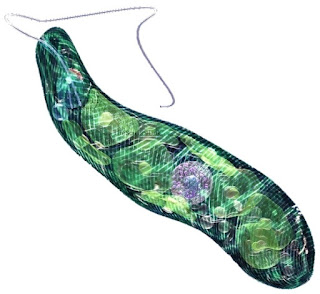NAVIGATING THE DEPTHS: AN IN-DEPTH ACCOUNT OF LOCOMOTION IN EUGLENA
Euglena, the single-celled marvel of the microbial world, possesses an exceptional ability to move gracefully through water. Its unique mode of locomotion is both intriguing and essential for its survival. In this article, we embark on an exploration of Euglena's locomotion, revealing the mechanics and significance of this captivating behavior in the microscopic realm.
THE WONDERS OF EUGLENA'S MOVEMENT
Euglena is renowned for its elegant and agile movement, which allows it to explore aquatic environments, find light sources for photosynthesis, and locate nutrients. The mechanism behind Euglena's locomotion is based on a whip-like tail called a flagellum, but it goes beyond mere swimming. To fully appreciate Euglena's locomotion, we must delve into the finer details.
THE FLAGELLUM: A MASTERFUL APPENDAGE
The key player in Euglena's movement is its flagellum. A flagellum is a long, thread-like appendage that extends from the front end of the cell and trails behind as Euglena moves. This structure is anchored to the cell's pellicle, a proteinaceous layer beneath the cell membrane, allowing it to protrude and retract with remarkable precision.
Euglena's flagellum is equipped with whip-like beating movements that propel the organism forward. These coordinated strokes of the flagellum create a twisting and bending motion, similar to a corkscrew, which is characteristic of Euglena's locomotion. The flagellum acts as both a propulsive and steering device, allowing the microorganism to navigate its surroundings with precision.
PHOTOTAXIS: SEEKING THE LIGHT
One of the most striking aspects of Euglena's movement is its ability to perform phototaxis, which is the movement toward or away from a light source. Euglena is photosynthetic, and it requires light for photosynthesis. To optimize its exposure to light, Euglena relies on its stigma or eyespot, a red or reddish-brown pigmented organelle near the base of the flagellum.
The stigma functions as a light-sensing structure, allowing Euglena to detect changes in light intensity. When the intensity of light increases on one side of the cell, the organism adjusts the beating of its flagellum to steer itself toward the light source. Conversely, if the light becomes too intense or harmful, Euglena will move away from it. This phototactic behavior is essential for Euglena's ability to maximize its photosynthetic efficiency and regulate its position in the water column.
CHEMOTAXIS: NAVIGATING TOWARD NUTRIENTS
Euglena's movement is not limited to phototaxis; it also engages in chemotaxis, a form of movement in response to chemical cues. When Euglena senses the presence of nutrients or other chemical substances in its environment, it can actively move toward them to obtain sustenance. This chemotactic behavior is crucial for locating and securing essential nutrients in its aquatic habitat.
THE ROLE OF THE PELLICLE
Euglena's pellicle, a unique proteinaceous layer located beneath the cell membrane, plays a significant role in its locomotion. The pellicle not only provides structural support to the cell but also offers resistance against the thrust generated by the flagellum's beating movements.
The pellicle is semi-flexible, allowing Euglena to change its shape and, consequently, the direction of its movement. As the flagellum beats, the pellicle deforms in response, enabling Euglena to twist, bend, and swim with great agility. This adaptability is a fundamental aspect of Euglena's locomotion and allows it to respond to changing conditions in its aquatic environment.
THE CELLULAR MACHINERY OF LOCOMOTION
Euglena's locomotion is not solely reliant on the flagellum and pellicle; it involves a complex interplay of cellular structures and organelles. The flagellar apparatus, a set of microtubules extending from the nucleus to the base of the flagellum, is responsible for coordinating the flagellum's movements.
Additionally, the cell's macronucleus, which is responsible for daily cellular functions, provides instructions for flagellar activity and movement. The macronucleus communicates with the flagellar apparatus to orchestrate the flagellum's precise and synchronized beating, ensuring that Euglena navigates effectively through its environment.
THE SIGNIFICANCE OF LOCOMOTION IN EUGLENA
Euglena's unique mode of locomotion is of utmost importance for its survival and adaptation to the aquatic environments it inhabits. Several key aspects highlight the significance of Euglena's locomotion:-
1. NAVIGATING TO OPTIMIZE PHOTOSYNTHESIS
Euglena is a photosynthetic organism, relying on light energy to convert carbon dioxide and water into sugars. Its ability to perform phototaxis allows it to seek out light sources, optimizing its photosynthetic efficiency and ensuring an adequate energy supply.
2. LOCATING NUTRIENTS
Euglena's chemotactic behavior is crucial for locating and securing essential nutrients, such as organic particles, bacteria, and other microorganisms. This ability to actively move toward nutrients ensures Euglena's nutritional needs are met.
3. AVOIDING HARMFUL CONDITIONS
Euglena's capacity to move away from intense light or harmful environments, such as excessive heat or chemical toxins, safeguards its survival. This phototactic and negative chemotactic behavior helps Euglena avoid conditions that could potentially damage its photosynthetic machinery or harm the cell.
4. ADAPTING TO CHANGING CONDITIONS
The flexible nature of Euglena's pellicle allows it to adapt to changing environmental conditions and navigate through the water column. This adaptability is essential for surviving in diverse aquatic habitats that may experience fluctuations in light, nutrient availability, and water depth.
THE COMPLEXITY OF MICROSCOPIC MOTION
Euglena's locomotion is a testament to the complexity of movement in the microscopic world. It showcases the precision and coordination required for a single-celled organism to thrive in ever-changing aquatic environments. The mechanics of flagellar beating, the role of the pellicle, and the integration of light and chemical sensing provide insights into the multifaceted nature of locomotion in Euglena.
As we explore the intricacies of Euglena's locomotion, we gain a deeper appreciation for the microcosmic wonders of the biological world. Euglena's ability to navigate the depths with elegance and precision is a testament to the marvels of life at the cellular level.
---:|| END ||:---






0 comments:
Post a Comment